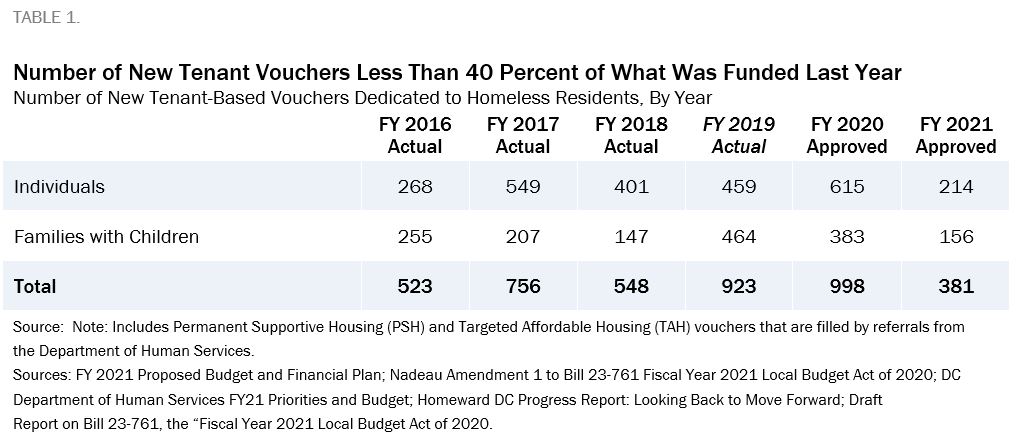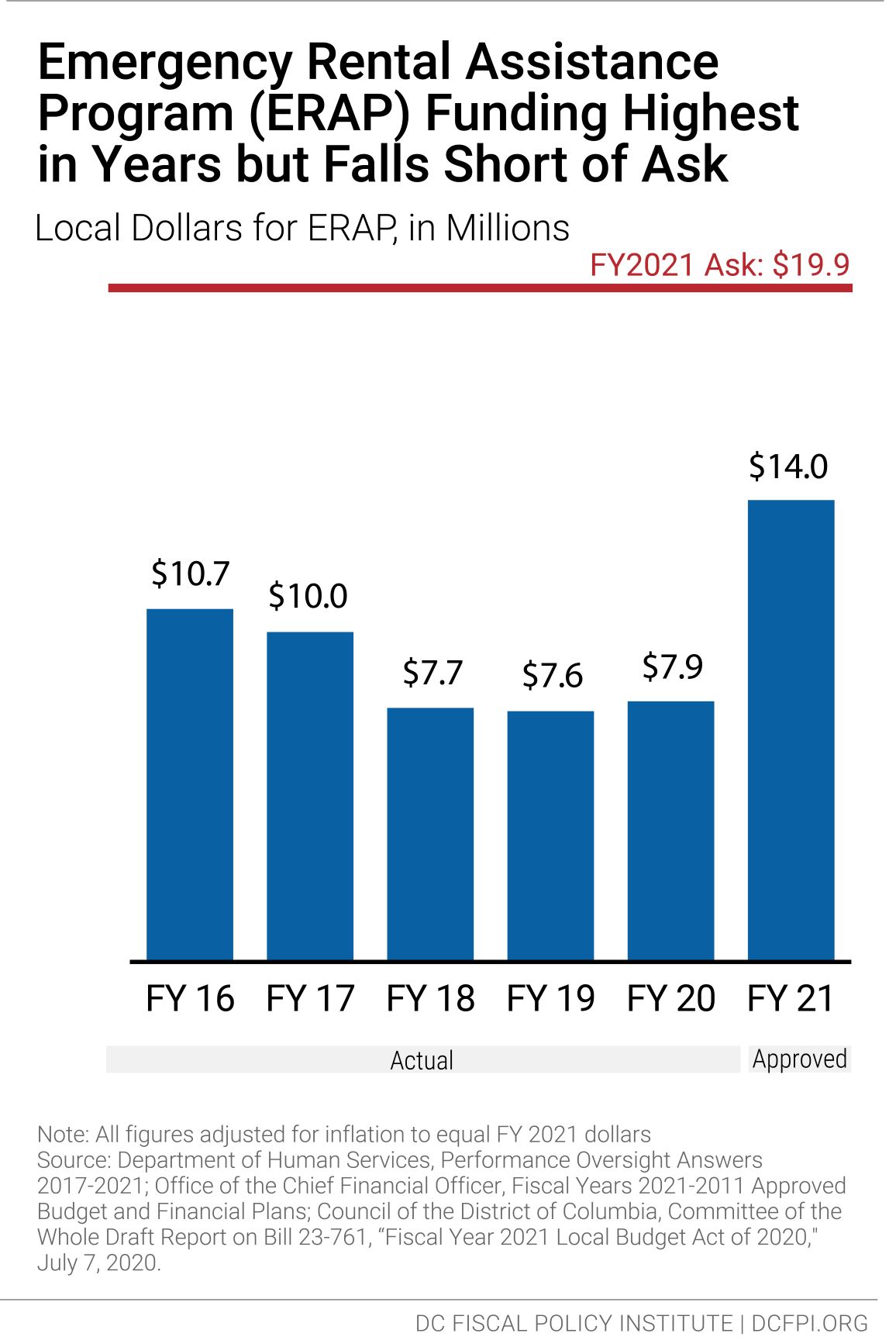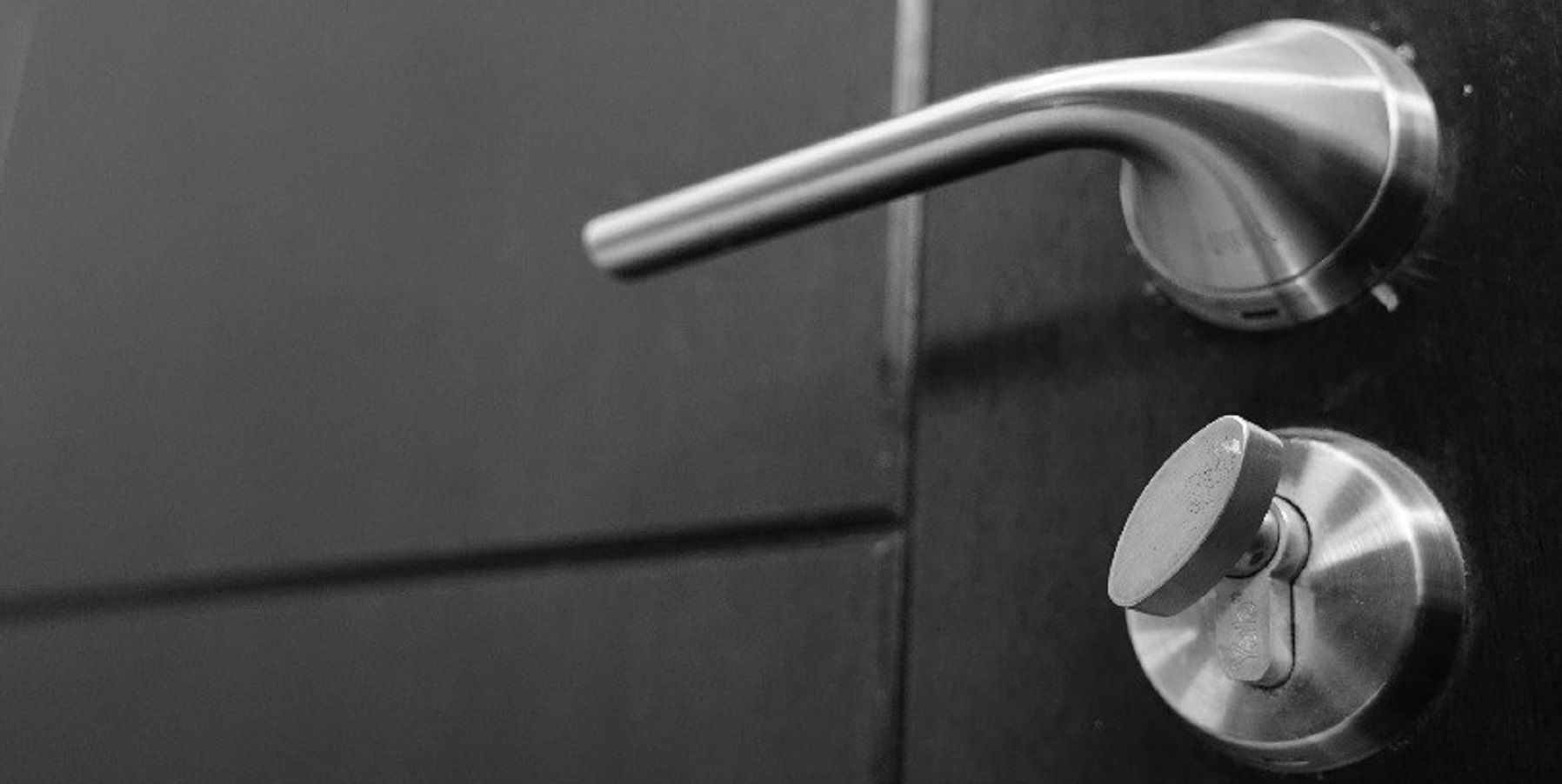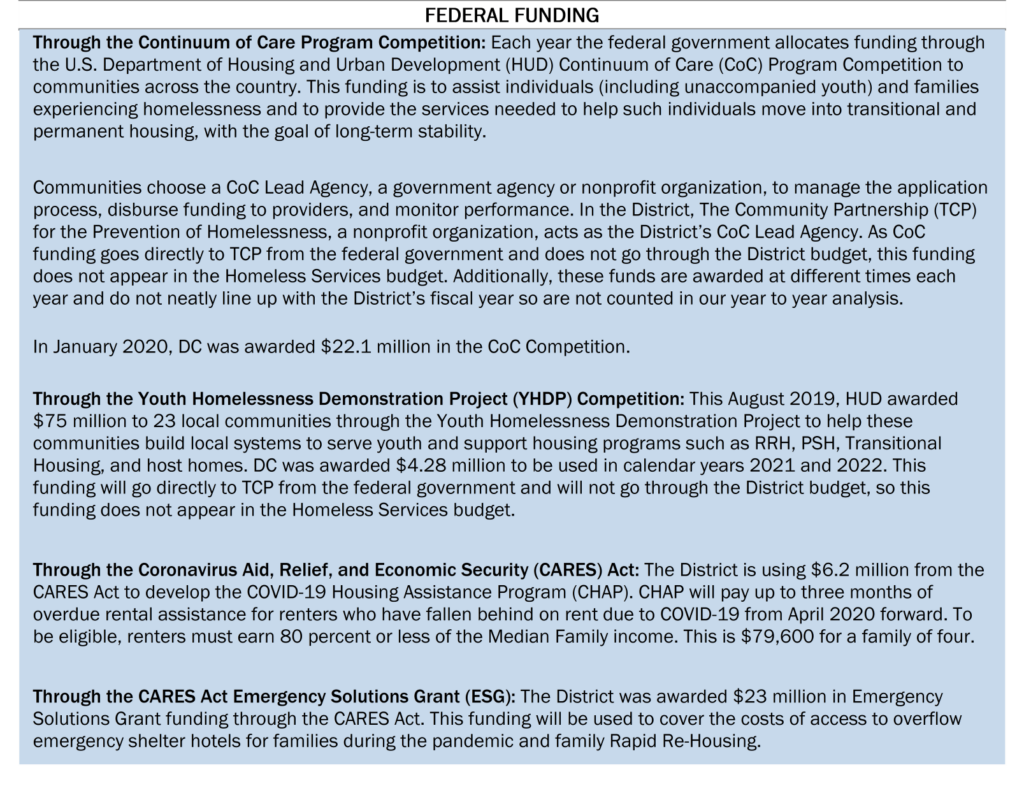- Across homelessness programs, the budget increases fixed costs by $8.7 million.
- DHS hopes to negotiate $11 million in savings in contracts and grants.
For individuals, the budget adds:
- $6.3 million for 214 new Permanent Supportive Housing (PSH) units. This investment is about 1/3 of what was funded in FY 2020.
- $2 million for a replacement for a current shelter hypothermia shelter that will not be available in FY 2022.
For families, the budget adds:
- Nearly $4 million for 96 new PSH slots and $2 million for 60 new Targeted Affordable Housing slots. These investments are 40 percent of what was funded in FY 2020.
- $12 million for family Rapid Re-Housing.
- $7.8 million for operating Short-Term Family Housing.
- $2 million for motel rooms used as family shelter.
- $204,000 for prevention.
- $1.7 million for small capital projects at 3 shelters.
For youth, the budget adds:
- $600,000 for 14 transitional housing for LGBTQ youth.
The budget also includes:
- $14 million for Emergency Rental Assistance Program. While this is a 76 percent increase from FY 2020, it falls far short of the need.
- $3 million for a new domestic violence emergency shelter.
- $1 million for a reentry housing program for men.
- $468,009 for 18 Local Rent Supplement Program rental vouchers for returning citizens.
- $1.35 million to build public restrooms.
Due to the economic crisis, lawmakers revised the fiscal year (FY) 2020 budget to address a mid-year shortfall and provide immediate relief to residents and businesses. They approved an FY 2020 supplemental budget at the same time that they passed the FY 2021 budget and made many decisions with both budgets in mind. This FY 2021 budget toolkit reflects some of the FY 2020 budget revisions.
The fiscal year (FY) 2021 budget provides the highest funding level ever for homeless services in the District. But the budget increases are the smallest they have been since the passage of Homeward DC, the 2015 plan to end homelessness among unaccompanied adults and families and in Solid Foundations, the 2017 plan to end homelessness among youth. The strategic plans, developed by the Interagency Council on Homelessness (ICH), aims to make homelessness rare, brief, and non-recurring.[1] The small investments made this year mean the budget doesn’t put DC on a path to ending homelessness soon.
People of color bear the brunt of DC’s affordable housing challenges. Nearly all extremely low-income households in DC who are housing insecure are headed by a person of color. And 86 percent of adults experiencing homelessness as defined by the US Department of Housing and Urban Development (HUD) are Black.[2] Individuals who are homeless are living in shelters, transitional housing, and places that are unfit for human habitation, such as cars.
Homelessness has a tight grip on Black residents due to the enduring legacies of structural and individualized racism—racist zoning and residential segregation, redlining, restrictive covenants, and practices barring federal employment, among other policies—that for years prohibited Black families from equitably accessing the housing and employment markets. This has led to the current racial wealth gap, as wealth accumulates over generations. Additionally, the historic denial of homeownership opportunities to people of color through discriminatory lending practices means that most Black residents, even middle-income residents, are renters—and rental costs have risen substantially.[3]
Additionally, “while federal and local housing policies are no longer explicitly discriminatory, private-sector racial discrimination persists,” explains researchers at the Center on Budget and Policy Priorities.[iv] Investigations have found that real estate agents continue to perpetuate segregation by denying Black families the opportunity to buy into high-value neighborhoods with stronger housing markets and better schools, which can help build wealth.[v]
Housing is healthcare. Every day individuals experiencing chronic homelessness—those who have been homeless for a long time and have serious health conditions—die from preventable and manageable diseases. Now, due to the coronavirus pandemic, the connection between housing and healthcare is even more evident when one of the keys to staying healthy is staying at home. Individuals who are homeless are particularly likely to acquire COVID-19 because of their age, vulnerability, exposure to many people while living in dormitory-style shelter, and/or inability to keep clean while living outside. And because of their health conditions, they are twice as likely to need to be hospitalized and two to three times likely to die from COVID.[6] These factors should have led to large increases in the voucher budget in FY 2021 rather than the relatively small investments that were made.
DC’s services for residents experiencing homelessness fall in four broad categories of services:
The Homeless Services Continuum for Families and Individuals
The District provides a variety of short-term and medium-term services for families and individuals experiencing homelessness. This includes shelter, the Homelessness Prevention Program (HPP), the Emergency Rental Assistance Program (ERAP), Rapid Re-Housing (RRH), transitional housing, and other programs. (These programs are described in more detail below.) Many of these services are delivered by private providers, either under contract with the DC Department of Human Services (DHS) or operate under the umbrella of The Community Partnership for the Prevention of Homelessness (TCP), an intermediary organization.
The Homeless Services Continuum for Youth
This includes family mediation, emergency shelter beds, transitional housing, RRH, Permanent Supportive Housing (PSH), and aftercare services which help youth maintain housing stability after exiting a program. Most of these services are delivered by private providers which either contract with DHS directly or operate under the umbrella of TCP.
Permanent Supportive Housing
This program provides long-term housing and intensive case management to residents—individuals, families, and youth—facing chronic homelessness who would otherwise have difficulty remaining housed. PSH helps people stay in housing and improve their health, which in turn saves a substantial amount of money. DC places some participants in apartments using rental subsidies, and others in buildings developed with District funding. Most of the services are delivered by private providers which either contract with DHS directly or operate under the umbrella of TCP.
Targeted Affordable Housing
This provides long-term affordable housing for formerly homeless residents—individuals and families—with no or minimal supportive services. Targeted Affordable Housing (TAH) helps residents who need help paying rent after their RRH ends or who no longer need the intensive services provided by PSH but still need help to afford housing.
Budget Includes a Mix of Homeless Service Expansions and Savings in FY 2021
The FY 2021 budget increases fixed costs for homeless services by $8.7 million. This increase is due to previous budgets not being sufficient to cover actual costs, and because the agency has to pay for maintenance, security, and utilities and the newly opened Short-Term Family Housing buildings. To help offset the costs of these increases in a recessionary budget year, the budget anticipates that DHS will be able to negotiate $11 million in savings in contracts and grants across homeless services that total $150 million. Nearly $1.6 million of the savings would be in youth services, with the rest across the remainder of the homeless services budget. Although the agency hopes these savings will not have a negative effect on services, it is not clear if that will be possible.
DHS pays the DC Housing Authority (DCHA) an administrative fee to manage its vouchers and Rapid Re-Housing rental payments. DHS hopes to negotiate this rate down from 8 percent to 6 percent, leading to additional savings.
Budget Falls Far Short of the Need on Chronic Homelessness
A large number of single adults in DC are chronically homeless. Families can also experience chronic homelessness, but it is less common. Among families facing homelessness, the main challenge is low income and the inability to afford DC rents. (See Budget Makes Only Small Investments in Family Housing Programs below.)
The approved budget makes new investments towards ending chronic homelessness but falls far short of what has been invested in previous years (Table 1). The approved budget includes nearly $6.3 million in new funding to provide PSH vouchers to 214 individuals and no new funding for TAH. The agency is planning to phase out TAH and instead create a PSH program with light services. This investment is just 14 percent of the estimated need of 1,500 slots for individuals—and is the smallest investment in vouchers for individuals made since the passage of the Strategic Plan.
The budget for RRH remains flat at nearly $4.2 million and will serve an estimated 440 people, far short of the 2,487 slots called for in the Strategic Plan. RRH for individuals provides housing search assistance, supportive services, and short-term rental assistance, generally for 3 to 6 months. The program aims to move residents out of shelters as quickly as possible, which in turn allows more residents to access emergency shelter.
Budget Makes Only Small Investments in Family Programs
The budget adds nearly $4 million to provide PSH vouchers for 96 families and $2 million to provide TAH vouchers to 60 families. This is less than half of the number of new slots that District lawmakers funded last year (Table 1).

The supplemental FY 2020 budget adds $12 million to the Family Re-Housing and Stabilization Program (FRSP), the RRH program that provides time-limited case management and rental assistance to families. This RRH program for families typically offers approximately 12 to 18 months of assistance, which is generally longer than for individuals. DC suspended terminations from FRSP from March through October to prevent evictions due to the pandemic, meaning families are staying in the program for longer periods, leading to increased costs.
The FY 2021 budget for RRH services for families is $30 million but this falls far short of what the agency anticipates spending, $44 million. The agency hopes to fill this gap with federal Emergency Solutions Grant (ESG) funding.
Budget Modestly Expands Services for Unaccompanied Youth Experiencing Homelessness
Many youth who experience homelessness do so without their parents or guardians and do not have children of their own. These “unaccompanied” homeless youth fall into two broad categories: those under age 18 and those who are 18 to 24 years old. In DC, youth under age 18 can only access housing and shelter dedicated to this population. Older youth, often called transition-aged youth (TAY), can access both TAY programs and adult housing and shelter.
The FY 2020 budget included $1.3 million in one-time funding for shelter beds for TAY. The FY 2021 budget includes another allocation of $1.3 million in one-time funding to replace this. To continue providing these beds in FY 2022, lawmakers will need to allocate more funding.
The budget includes $600,000 for 14 new units of transitional housing for LGBTQ youth. LGBTQ youth are overrepresented in the homeless population and are particularly vulnerable. 34 percent of youth who responded to the 2019 DC Youth Count reported they were LGBTQ, compared to only 7 percent of youth reporting this nationally.[7] And LGBTQ youth experiencing homelessness are at greater risk of victimization for sexual exploitation and trafficking, sexually transmitted diseases, and developing mental health problems—including suicidal ideation and attempts—than other youth experiencing homelessness.[8]
DHS also agreed to increase the per bed allocation for extended transitional housing (ETH) placements from $34,236 to $50,000, without reducing the number of funded ETH beds, 86 beds. ETH includes housing and intensive supportive services for the most vulnerable youth ages 18 through 24 years of age for up to six years, with the goal of stabilizing the youth and preparing them for independence as they transition to adulthood. Although advocates were hoping to get a per bed allocation of $55,000, the increase brings the per-bed cost above that of Transitional Housing placements and on par with the per-bed price of longer running ETH programs.
Budget Includes Additional Funding for Operations of Motels and New Short-Term Family Housing
The budget adds $7.8 million for operating costs at the new Short-Term Family Housing buildings. Some of these buildings were only open for part of FY 2020, so the operating budget for FY 2021 reflects an increase to account for a full year of operations in FY 2021. The budget also increases to support the Ward 1 shelter building, which will open in FY 2021.
The budget adds $2 million to pay for hotel rooms used as family shelter. DHS had anticipated that they would no longer need hotels in FY 2021, but there have been delays in opening the Short-Term Family Housing buildings. In addition, families are staying in shelters for longer periods of time because it is more difficult to move out during the public health emergency.
Budget Includes Funding for New Domestic Violence Shelter
Funding for shelter and services for survivors of domestic violence is housed in both DHS and the Office of Victim Services and Justice Grants (OVSJG). The FY 2021 budget includes $3 million in one-time funding in the OVSJG budget for a new emergency shelter for survivors.
Budget Expands Funding for Reentry Housing Program
The OVSJG budget includes $1 million for a reentry housing program for adult men returning from incarceration.
The DC Housing Authority budget includes $468,009 for 18 Local Rent Supplement Program (LRSP) rental vouchers for returning citizens.
Budget Expands Funding for Eviction and Homelessness Prevention Programs
The FY 2021 budget for the Emergency Rental Assistance Program is $14 million, a 76 percent increase from the FY 2020 budget, when adjusted for inflation (Figure 1). ERAP helps residents facing eviction pay for overdue rent and related legal costs. The program also provides security deposits and first month’s rent for residents moving into new homes. ERAP funding runs out every year.

Despite the significant increase in the budget, it is likely that the budget will fall far short of the need, given the COVID-19 crisis:
- The Brookings Institute estimates that it would cost nearly $5.5 million per month to serve households in need earning less than $20,000 annually and an additional $5.1 million per month to serve households earning between $20,001 and $40,000.[9]
- Paying for the six months of rent arrears between April and September that residents have likely accrued since the start of the COVID-19 crisis would cost $33 million for those earning less than $20,000 and an additional $30.6 million for those making between $20,001 and $40,000.[10] It is likely the crisis will continue, meaning households will need additional funds.
- The FY 2021 ERAP budget is just over $14 million and the federally funded CHAP budget is $6.2 million. This will cover less than two months of rental arrears[11] for households earning up to $40,000.
Right now, evictions are prohibited until 60 days after the Public Health Emergency (PHE) expires. The current expiration date for the PHE is October 9th, meaning evictions can start on December 9th, but the PHE may be extended. The Brookings Institution estimates that more than 9,500 households will need rental assistance.[12]
The Project Reconnect budget remains flat in FY 2021. Project Reconnect is a program that helps individuals who are newly homeless find alternatives to shelter, such as reuniting with friends and families. It is anticipated that the program will serve 1,000 people.
The budget adds $204,000 to expand the Homeless Prevention Program, which works to prevent a family at imminent risk of losing housing from becoming homeless through the provision of stabilizing services and resources.
The District has received federal funding that it plans to use for eviction prevention for households facing eviction because of COVID-19. See Federal Funding box for more information.
Budget Includes Small Decrease in Street Outreach Funding
The FY 2021 budget includes nearly $3.5 million for street outreach, a small decrease from the FY 2020 budget of nearly $3.7 million. Outreach services primarily target hard-to-reach individuals who do not seek shelter or other homeless services. Outreach workers help these individuals to apply for housing and gain necessary documentation. They also help them connect with vital services like mental and physical healthcare. It is anticipated that the same level of services will be provided in FY 2021 as in FY 2020, despite the small decrease in the budget.
Budget Preserves Funding for Building Public Restrooms, But Removes Funding for Business Incentives
DC has only three public restrooms that are open 24 hours. This leaves many residents, particularly residents experiencing homelessness, with no place to go. The budget preserves the $1.35 million put into the Department of General Services six-year capital budget in 2020 to build 10 standalone restrooms. The Committee on Facilities and Procurement redirected $55,043 that was included in the FY 2020 budget for operations of public restrooms to street outreach. It is not anticipated that any of the restrooms will be complete in FY 2020, so there will be no need for operations funding.

The FY 2021 budget removed $62,000 in annual funding included in the FY 2020 budget to offer incentives to businesses to open their bathrooms to the public. The program is on hold until funds are appropriated for it.

Homeless Services Capital Budget Invests in Shelters and Removes Funding for a PSH Building
The capital budget includes nearly $36.3 million to build a 200-bed replacement for the Harriet Tubman Women’s Shelter which is in an aging building that was never intended to be a shelter. The new shelter will have space for a health clinic, daytime programming, computer lab, and private case management.
The capital budget removes $21 million that the Mayor added in the FY 2020 budget to build a new PSH building for women. The administration decided to use an already finished building. The administration gave a $3.2 million annual Local Rent Supplement Program contract to the private owners of this building. This contract will subsidize rent for 100 women, and DHS will execute a separate contract to find an organization to provide and coordinate services.
The budget also includes $2 million to retrofit a District facility to be used as a hypothermia shelter for 100 individuals, as the currently used Malcolm X facility will not be available in FY 2022.
Finally, the budget includes $1.7 million for small capital projects at three family shelters.
[1] District of Columbia Interagency Council on Homelessness, “Homeward DC: Strategic Plan to End Homelessness 2015- 2020.” District of Columbia Interagency Council on Homelessness, “Solid Foundations DC: Strategic Plan to Prevent and End Homelessness, revised May 2017.
[2] The Community Partnership For The Prevention of Homelessness, “2020 Point-in-Time Count of Persons Experiencing Homelessness in the District of Columbia,” July 2020.
[3] Andrew Aurand, Dan Emmanuel, Daniel Threet, Ikra Rafi, and Diane Yentel, “The Gap: A Shortage of Affordable Homes,” National Low Income Housing Coalition, revised March 2020.
[4] Michael Leachman, Michael Mitchell, Nicholas Johnson, and Erica Williams, “Advancing Racial Equity With State Tax Policy.” Center on Budget and Policy Priorities, revised November 15, 2018. This research is summarized in Editorial Board, “How Segregation Destroys Black Wealth,” New York Times, (September 15, 2015)
[5] Ibid.
[6] Dennis Culhane, Dan Treglia, and Ken Steif, “Estimated Emergency and Observational/Quarantine Capacity Need for the US Homeless Population Related to COVID-19 Exposure by County; Projected Hospitalizations, Intensive Care Units and Mortality,” revised March 27, 2020.
[7] “2019 Youth Count DC Presentation to DC ICH Youth Committee,” The Community Foundation For The Prevention of Homelessness, February 2, 2020.
“Solid Foundations DC”
[8] “Solid Foundations DC”
[9] Michael Bailey, Eric LaRose, and Jenny Schuetz, “What will it cost to save Washington, D.C.’s renters from COVID-19 eviction?” Brookings Institute, July 2020. These figures are those who report being behind on rent and have income that falls inside the 2 bands: under $20,000 and between $20,0001 and $40,000.
[10] Ibid.
[11] Ibid.
[12] Ibid.
